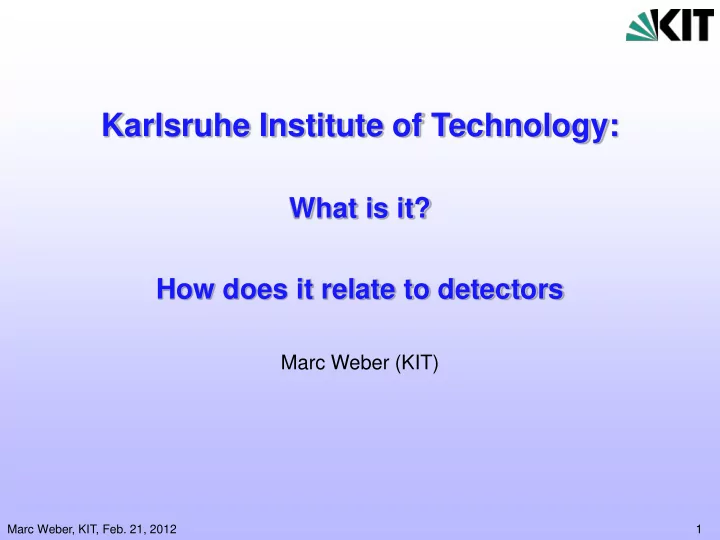

Karlsruhe Institute of Technology: What is it? How does it relate to detectors Marc Weber (KIT) Marc Weber, KIT, Feb. 21, 2012 1
Where is KIT ? Central and scenic location in Southern Germany State of Baden-Württemberg Close to Black Forest Close to France 1h by train from Frankfurt airport 2h by car from Switzerland 3h by train from Paris Marc Weber, KIT, Feb. 21, 2012 2
What is KIT ? Karlsruhe University + FZK = KIT Marc Weber, KIT, Feb. 21, 2012 3
Marc Weber, KIT, Feb. 21, 2012 4
KIT in numbers Marc Weber, KIT, Feb. 21, 2012 5
KIT in HGF programs Marc Weber, KIT, Feb. 21, 2012 6
Faculties Most relevant for detector portfolio are arguably: Physics Electrical engineering and information technology Informatics (“computer science”) Mechanical engineering Marc Weber, KIT, Feb. 21, 2012 7
Institutes Of the 157 institutes are arguably most relevant for detectors: • IEKP, IKP, IPE, ISS/LAS (particle physics, astroparticle physics, electronics, synchrotron radiation) • IHE, IMS, IQP, ITIV (high frequency radiation and electronics, superconducting detectors, quantum photonics, embedded systems) • IMT, INT (micro and nano technology) Marc Weber, KIT, Feb. 21, 2012 8
A glimpse at physics experiments Auger, Belle II, CMS, EDELWEISS, KATRIN Marc Weber, KIT, Feb. 21, 2012 9
A glimpse at technology infrastructure • Grid Computing Center Karlsruhe (GridKa) • Tritium Laboratory Karlsruhe (TLK) • Proton Irradiation Center • Electron beam lithography for superconducting sensors • Superconducting magnet test facility (TOSKA) • Microassembly and -hybridization lab Marc Weber, KIT, Feb. 21, 2012 10
Hot Electron bolometer (IMS) 25 20 20 Signal amplitude (mV) 15 Ultra-fast YBCO detector Signal amplitude (mV) 15 10 42 ps 10 5 THz antenna 5 0 0.0 0.1 0.2 0.3 0.4 0.5 0 Time (ns) 0 10 20 30 40 50 60 70 80 Time (ns) Ambient temp I Bias T/H Amp ADC HEB DC block 2 x 5 μ m 2 Area Digitalization Detector stage Wideband LNA Resolution < 5 ps (Low Noise Amplifier) Cryogenic temp (7 – 70K) Channels 1 80 μ W Power Data Rate ~ 100 GS/s (peak) P . Probst et al., APPLIED PHYSICS Trigger yes LETTERS 98, 043504 (2011) Temperature 77 K Mass - Radiation hardness - Marc Weber, KIT, Feb. 21, 2012 11
Non-silicon sensors (FMF and KIT) Silicon is not a great X- ray absorber… CdTe detector Crucial for hard X-rays. Needs: crystal growing and characterization; contacts and flip-chip technology at low temperatures (65K 55 μ m pixels) Pictures: M. Fiederle (FMF und KIT) Marc Weber, KIT, Feb. 21, 2012 12
3D Ultrasonic Computer Tomography (USCT) • Application: mammography • 10% of western women develop breast cancer • High survival probability if detected early • 3D USCT gives excellent spatial resolution in 3D • No X-rays 3D USCT • Cheaper than MRT Volume 8 liter < 200 μ m Resolution Ideal for regular mass screening Channels 1413 Power < 1.5 kW Data Rate 50 Gb/s Trigger N/A 30 ° C Temperature Mass - Radiation hardness - Marc Weber, KIT, Feb. 21, 2012 13
Thank you and my apologies for the pace and the omissions … Marc Weber, KIT, Feb. 21, 2012 14
Recommend
More recommend